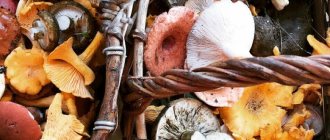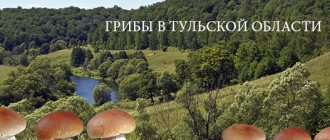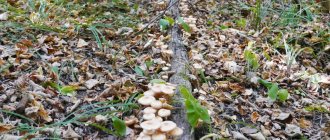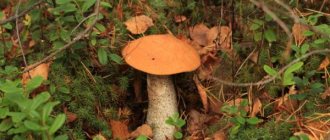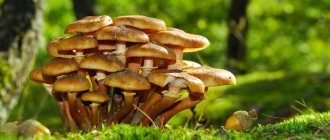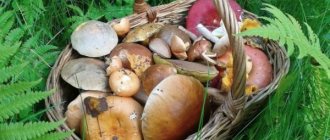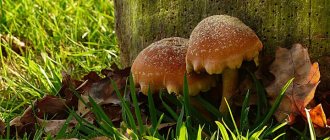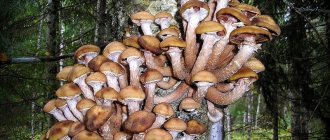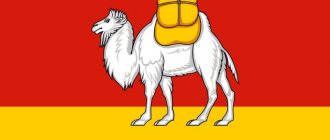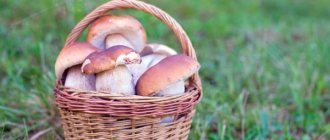Mushrooms
0
1828
Article rating
Kira Stoletova
The opening of the mushroom season in Kostroma begins in the summer. Mushrooms in Kostroma grow abundantly after heavy rains and wet weather. Studying their characteristics and geography of distribution will allow you to find a decent harvest of various species and stock up on provisions for the winter.
Popular mushrooms in Kostroma
Bruise
The bruise is a representative of the tubular species, otherwise called birch gyroporus, blue gyroporus, protected by law.
Description of the leg:
- average thickness, diameter 3 cm;
- height 3-11 cm;
- thick at the base, tapering towards the cap;
- the pulp is solid, loose in young specimens, cavities appear in adults;
- white or gray-brown.
Description of the hat:
- hemispherical, convex, eventually flat;
- diameter 4-16 cm;
- velvety;
- turns blue when pressed;
- The flesh is cream-colored and turns blue quickly.
Spore powder is light yellow in color.
Found in deciduous and mixed forests, prefers to grow near birch trees. It is an active mycorrhiza former.
Despite the good taste, mushroom pickers are often put off by the color of the pulp.
Inedible and poisonous mushrooms of the Kostroma region
You can get poisoned by mushrooms by eating inedible and poisonous ones, but there is also a chance of getting health problems from improperly preparing completely edible ones. You should not pick mushrooms that are damaged, old, or wormy. Mushrooms absorb harmful substances from the soil and air, so you should not collect them near industrial facilities, highways and roads, and other sources of environmental pollution.
There are quite a lot of dangerous mushrooms in the Kostroma region, which any mushroom picker going into the forest should know.
False honey mushrooms
They are practically a copy of their edible counterparts, but of course there are some differences between them. False honey fungus differs from the usual one in the color of the plates on the stem. The false one has a gray-yellow hymenophore, and the edible one is cream-colored; older specimens darken over time.
Mushroom pickers often call the following types of mushrooms false honey mushrooms:
- saprophytes of the genus Hypholomas, parasitizing old wood;
- some representatives of pstirella - pstirella velvety and Kandolla;
- This also includes brick-red and sulfur-yellow honey fungus.
False honeysuckers are distinguished by the semblance of a skirt on a leg.
Bile mushroom
These mushrooms resemble boletus mushrooms. You can recognize a poisonous one by its incision; the gallbladder has a pinkish layer resembling a sponge; its leg on top is dark with a mesh pattern on a light background. The gall mushroom tastes very bitter, but it is not worth trying it in the forest.
Death cap
Their cap can be white, olive or grayish. Young specimens have an ovoid cap with a diameter of up to 15 cm, but over time it becomes flatter.
Porcini
The white mushroom cap can grow up to 31 cm
The white mushroom cap has the following characteristics:
- dark brown;
- there is rarely a violet glow;
- diameter 6-31 cm.
The pulp is white, dense, juicy. The color does not change when cut, there is a pleasant smell. The tubular hymenophore is finely porous, usually white in young specimens, gray or yellowish-green in older specimens.
Russula brownish
It grows in the Kostroma region from July to October.
Description of the hat:
- diameter 3-11 cm;
- convex in early life, flat with depression in adulthood;
- the skin is matte;
- red-violet, sometimes with spots;
- the plates are cream-colored or ocher.
The leg has the following features:
- round in cross-section;
- height 6-9 cm;
- thickness up to 4 cm;
- white-pink, white-carmine;
- turns brown when damaged.
The pulp is dense, white, which changes color when cut - turns brown or yellow. The smell is weak, but as it dries it intensifies and resembles the smell of seafood - in particular shrimp.
When does the mushroom season begin in the Kostroma region?
Autumn is mushroom time for the entire Central Russia. To collect a complete basket, you need to know the exact places where you should go and what mushrooms are in a particular location. There are many mushroom places in the Kostroma region, there are enough forests and forest plantations, clean ecology also plays into the hands of mushroom pickers, there are no large metallurgical, coal mining and other hazardous industries. On specialized forums, mushroom pickers share their experiences, naming the most generous places in the region.
A large number of mushrooms grow in the region and almost all of the most popular edible ones. Some fans open the season already in May.
Scutellina saucer-shaped
Can be collected from May to October, grows on rotting wood, on soil - at the base of stumps, loves damp, marshy places. The body is smaller than a coin, saucer-shaped, bright red. The pulp is brittle and waxy.
Scutellia saucer belongs to the ascomycetes, or marsupial fungi. This means that spores develop in her special formations - bags, or asci.
Irina Selyutina (Biologist):
The shape of the fruiting body of the fungus changes depending on age: at first it is spherical, and later it becomes disc-shaped or flat-saucer-shaped. The inside of the mushroom is bright red or cherry-red, but the outside is yellow-brown. Along the edges of the fruiting body there are black or dark brown bristles, which form a kind of “fringe”. The pulp has a reddish color, but there is no special smell inherent to the species.
Due to its small size, the mushroom has no culinary value and is considered inedible.
Visiting the Snow Maiden and Susanin: a gastronomic journey around Kostroma
Kostroma cheese is the first thing that comes to mind when it comes to the gastronomic specialties of the region. However, the Kostroma residents themselves are proud of their “special” green cabbage soup, fatty Galich pike, black milk mushrooms and “manly” salad.
Once upon a time, the great Russian playwright Alexander Ostrovsky, himself from a Kostroma family, said: “What rivers, what mountains, what forests!... If this district were near Moscow or St. Petersburg, it would have long ago turned into an endless park, it would compared with the best places in Switzerland and Italy...”
And indeed, when he came to his Shchelykovo estate near Kostroma, the writer not only rested, fished, picked mushrooms or hunted - he wrote a lot and with pleasure.
It was on the Kostroma estate that “The Dowry”, “The Snow Maiden” and a dozen more plays were written.
And they always sit down at the table in them, talk about making jam and salting cucumbers, put bottles of tincture on the windows, buy a year’s supply of fish, honey and cabbage.
By the way, did you know that the central square of Kostroma is popularly called “Skovoroda”?
Provisioning master
Masleniki and butchers, bread makers, Kalashniks and kvass makers, fish catchers and gopher makers, empty makers, pancake makers and gardeners - masters of more than 28 specialties lived in Kostroma long before the time of Ostrovsky. Many of them were engaged only in the production of food products, other craftsmen also traded - “they beat butter and sell”, “they bake bread and sell.”
Volga fish, caught and prepared in Kostroma, were fed to the royal court. The assortment of the Fish Row (the riverside area of the city - editor's note) was amazing in its diversity - from bream and pike to red fish, sturgeon, sterlet and white fish.
On the banks of the Volga, in the area of the former Uspensky Lane, there was the sovereign’s Rybnaya Sloboda with a “fish garden”, “and fishermen plant live fish in it. Yes, there is a glacier near the Volga.
And they keep fresh fish in it on ice for the sovereign’s use,” they wrote in documents of the 18th century.
The main products, known far beyond the Kostroma province, were also lard, cow butter and hops. Kostroma lard was exported through Arkhangelsk. Hops were exported to hundreds of breweries, and milk and butter subsequently replaced the famous “Kostroma” cheese in exports.
Fish rows
Do you remember the episode of the wonderful film by Eldar Ryazanov, when the crazy Paratov invites all the heroes onto his ship? The merchant's celebration takes place in Kostroma, and the main decoration of the table was, of course, a huge sturgeon. Now there are not a lot of sturgeon in Kostroma, but you can find pike - the famous Galich pike.
This fish has a glorious history. Pike from Lake Galich were valued hundreds of years ago. In the 18th century, a charter to catch local fish was given personally by Catherine II.
And the fishermen, treated kindly by the imperial attention, were called “pharaohs” by the Galicians. The descendants of the “pharaohs” today take part in the festival “At the command of the pike” and cook Galich pike fish soup right on the shore.
The recipe is simple, but the secret is that you need to cook it from lake pike on the shores of Lake Galich.
And in the village of Bogovarovo, Oktyabrsky district, Kostroma region, Village Day is held, in which housewives compete in preparing traditional food. Last year, the main prize was won by Zinaida Smolyaninova and her fish pie. Here's how it's prepared:
We made ordinary yeast dough. River fish, not very bony, was dried on a towel (not fried). Along with the fish, a lot of onions (also not fried) were placed on the bottom and top (green in summer).
The filling was placed in the center of the rolled out dough so that the edges could then be folded over like an envelope. When baked, turn over so that the seams are on the bottom. The pie turned out to be square. Baked in a Russian oven.
When serving, they were brushed with melted butter, the top crust was cut in a circle, then this “lid” was cut into small squares.
Cabbage soup and porridge are our joy
Who in Russia can you surprise with cabbage soup? However, each region has its own cooking characteristics. In Kostroma, for example, they are cooked not from traditional white cabbage, but from the hard, green upper leaves. Previously, they were separated, chopped and salted separately - only for cabbage soup. And such a preparation was called “puppy” or “shchanitsa”.
They fermented “shchanitsa” in oak tubs, which were not washed, but only thoroughly dried in the sun in the summer.
“Green” cabbage soup was cooked on a good sugar pit. The pot of cabbage soup was simmered in a Russian oven all night. At the same time, the cabbage becomes soft and slightly sweet - this gives Kostroma cabbage soup a unique taste. Kostroma cabbage soup is served with homemade sour cream and hot pies.
Porridge was also an obligatory dish on the table of Kostroma residents. They cooked it as a separate dish, as a side dish, and even as a dessert.
An interesting recipe for porridge prepared like gingerbread has been preserved. To do this, you need to cook a cool porridge in salted water from all the cereals that you can find in the house. The less water used, the better.
Place the porridge on a table, board or plate and spread it with a knife so that the layer thickness is 1–2 cm. When the porridge cools and dries, it must be cut into strips the thickness of a finger.
Roll the resulting pieces in egg yolk and fry in oil. You can eat this porridge by dipping it in jam.
“Kostromskoy” and “Susaninsky” cheeses
Kostroma is still called the “cheese capital of Russia”. Each region used to have its own pride: in Nerekhta - sour cream, in Manturovo - cottage cheese, cheese - in Kostroma and Susanino, butter - in Bogovarovo. Milk was provided by cows of their own breed, Kostroma.
The production of hard cheeses began in 1878. After 100 years, Kostroma factories produced up to one and a half thousand tons of Kostroma and Susaninsky cheeses.
The latter, by the way, is named not after the hero Ivan Susanin, but after his native village Susanino. In general, outside the region, besides “Kostroma”, local cheeses are almost unknown - “Demidov”, “Voskresensky”, “Ivan Kupala”.
Therefore, tourists have the opportunity to bring a delicious souvenir with them.
Black milk mushrooms with black salt
On the local market, a liter jar of salted milk mushrooms costs about twice as much as a choice pork tenderloin. But both locals and tourists buy them much more willingly. Milk mushrooms are collected only in untouched birch groves in the northeast of the Kostroma region. The Parfenyevsky district is especially famous.
//www.youtube.com/watch?v=8dpO7UWZ_og
In tsarist times, the famous Parfenyev milk mushrooms were supplied to the royal table. And the locals perceived mushrooms as bread, they said: “If it’s mushroomy, it’s bready.”
Mushrooms have been eaten here since the very first ones - in May. The fresh ones were placed in cast iron pots and left to simmer in the oven for the whole day. From fresh mushrooms, which were called “lips” here, they cooked “gubovnitsa”, and from salted ones they made “mushroom mushroom”. And for the holiday, milk mushrooms were served, generously flavored with coarsely chopped onions and thick sour cream.
Nowadays the “Kostromskaya” salad is also popular, also, of course, with mushrooms. The ingredients are simple: black radish - 2 pcs., carrots - 1 pc., boiled beef - 300 g, salted mushrooms - 0.5 cups, garlic - 3-4 cloves, mayonnaise - 3 tbsp. spoons and 100 g of “Kostroma” cheese.
Grate the radish and carrots on a coarse grater. Cut the beef, cheese and washed mushrooms into strips. Add garlic and mayonnaise, stir.
Black salt
Black salt is made only in the Kostroma region. The unusual product is called “Thursday salt” because in former times it was prepared only once a year - on Maundy Thursday (before Easter).
Nobody knows for sure who first came up with this recipe. But it is known that salt production in Kostroma has existed since the 14th century.
The valuable mineral was mined in Soligalich, 100 kilometers from Kostroma, and ground there in windmills. To make the salt black, it was mixed with rye flour and fired in an oven.
Salt prepared in this way becomes very useful: it increases the content of potassium, calcium and magnesium.
Moose milk
The Sumarokovskaya moose farm is located 20 km from Kostroma. This is the only place in Russia where moose are bred and milked, producing milk that is rare in its usefulness.
Scientists believe that elk milk treats stomach and duodenal ulcers, is used for radiation injuries, for the prevention of cytostatic dysbacteriosis, and in the treatment of patients with lymphogranulomatosis.
Moose milk can be stored for a long time frozen at liquid nitrogen temperature without losing its medicinal properties.
Tourists can come here on their own. A tour of the farm is given by those who care for the moose and know everything about them. You can pet moose babies and feed them carrots—they gently take it from your palm and try to kiss you in gratitude.
Two-year-old Sukhlyanka
A synonym for the name is the name dark sukhlyanka.
Hat characteristics:
- diameter 2-10 cm;
- round, funnel-shaped in young specimens, flattened in adults;
- thin-fleshy;
- at first matte, later naked, yellow-ocher;
- the caps grow together or blades of grass grow between them.
The leg looks like this:
- height 1-4 cm;
- diameter 0.6 cm;
- central, narrowed;
- brown, matte, velvety.
The pulp is rust-colored and thin in structure. Without taste and smell. Mushrooms are common from July until the end of autumn.
Summer honey fungus
Honey mushrooms grow in groups
When several honey mushrooms appear, it is recommended to continue the search; they are common in forests in groups. They are used for:
- frying;
- pickles.
The hat has the following features:
- wide dark on a thin, often straight stem;
- fragrant aroma with a honey note;
- diameter 10 cm;
- honey or brown color.
The pulp is sandy, brownish-brown, the stem is thin up to 1.1 cm in diameter, grows up to 11 cm.
Gumaria hemispherical
The fruit body has the shape of a hollow ball and breaks at the top. At a young age, the mushroom material resembles a goblet, later it becomes cup-shaped and saucer-shaped. It grows up to 3.5 cm in width. The inner side of the fruiting body is light matte, the outer side is brown. The species has no legs and no smell. The pulp is light, brown, dense.
Irina Selyutina (Biologist):
Gumaria hemispherica is a terrestrial discomycete, i.e. a fungus that is part of the non-taxonomic group of ascomycetes. It is characterized by a whitish or grayish inner surface, which may occasionally have a pale blue color. The “bottom” of the inner part of the apothecium may be wrinkled and resemble semolina porridge in consistency. This inner part is the spore-bearing surface (hymenophore). The outer part is sterile, brown and covered with hard brown hairs protruding 1 mm above the edge of the mushroom. The pulp is thin, waxy, tasteless and odorless. The mushroom is considered inedible due to its size. There is no information about toxicity.
Gumaria hemispherical is common in damp places, grows in summer and autumn and not every year.
What to do if you get lost in the forest
- Do not panic!
- If you have a mobile connection, call 112
- If the phone does not work, then you need to listen to the noise: in quiet times, the noise of a tractor can be heard 3-4 km away, a running train 10 km away, a dog barking 2-3 km away, loud screams 1 km away, car horns 2-3 km away, the sound of an ax and the noise of a motorcycle 500 meters away.
- Rescuers from the Ministry of Emergency Situations recommend paying attention to landmarks before entering the forest: which side the sun is on, which direction the river flows. For example, if when entering the forest the sun shines in your face, then when you exit it should be behind you. An even more reliable landmark is a river or stream - when entering the forest, pay attention to which direction the water flows and, if you get lost, go out in the opposite direction to the flow.
- If you realize that you are circling in one place, don’t worry. This is called the “right leg trick”, people always have one step shorter than the other, so you will definitely skid to the side.
Always take matches or a lighter with you!
The opening of the mushroom season in Kostroma begins in the summer. Mushrooms in Kostroma grow after heavy rains and wet weather. Studying their characteristics and geography of distribution will allow you to find a decent harvest of various species and stock up on provisions for the winter.
The mushroom harvest can be harvested after rainy weather in areas 100-200 km from Kostroma:
- Antropovsky;
- Kadyisky;
- Makarievsky;
- villages Fatyanovo, Samylovo;
- Pavino is the place where Ryzhikov is harvested;
- Kologrivsky, Mezhevsky districts - a lot of porcini mushrooms;
- Potrusovo – there are a lot of mushrooms growing in the village.
There are many types of mushrooms in Kostroma and the region. After the rains in May and June, a large mushroom harvest is expected.
- Bruise;
- White;
- Milk mushrooms;
- Russula turns brown;
- Scutellina saucer-shaped;
- Sukhlyanka biennial;
- Summer honey fungus;
- Boletus;
- Gumaria hemispherical;
- Trametes variegated;
- Birch polypore.
The map of mushroom places in Kostroma is varied, many different species grow further away from Kostroma. Having studied the characteristics of mushrooms and their distribution in the region, it will be possible to make decent supplies for the winter.
Trametes multicolored
The second name is variegated tinder fungus. The fruiting body is perennial. Reaches 2-6 cm in length, grows to 4-10 cm in width. Multi-colored trametes has a fan-shaped or round shape. Representatives of the species are characterized by the absence of a stalk in the structure of the fruiting body. Therefore, such mushrooms are called sessile; they grow on one side of the wood. Several fruiting bodies are able to grow together into a single complex. The mushroom is soft and silky to the touch. Tramates happens:
- grey;
- yellow;
- blue;
- brown.
After drying, the fruiting body of the mushroom turns white. The pulp smells pleasant. The hymenophore is tubular, yellowish in young specimens, brownish in older specimens. In the Kostroma region, these mushrooms are rarely found; they appear on rotten stumps and wood.
Mushroom places of the Kostroma region
In 2022, according to experienced mushroom pickers, there will be the following places and areas:
- Samylovo village;
- Fatyanovo village;
- Kadyisky and Antropovsky districts of the region;
- Pavino;
- Mezhevsky and Kologrivsky districts;
- Potrusovo village.
In each place one or another type of mushroom predominates. 2022 promises to be a fruitful year for mushrooms, so lovers should take a closer look at these locations and visit them at least once a season.
Mushroom places in the Kostroma region and what mushrooms grow here:
- village of Sentsovo - boletus;
- village of Ulyanovo, town of Vasilyevo - milk mushrooms and boletus grow here in abundance;
- village of Baksheyka – chanterelles, volushki;
- Makaryevo village – porcini mushrooms;
- Pasino village – saffron milk caps;
- Pasma village (Kologrivsky district), as well as Mezhevsky district - boletus mushrooms;
- Potrusovo village - milk mushrooms.
Among the mushroom places in the Kostroma region there are the most basic directions where a large number of mushroom pickers go, thereby reducing the likelihood of getting a large harvest. Bychikha and Vasilevo are considered such places. It is also worth saying that there are practically no mushrooms in Kostroma itself, so you will have to go out of town to collect them.
For convenience, mushroom places in Kostroma are marked on the map to make it easier to get to them, especially for novice mushroom pickers.
Birch polypore
Or as it is popularly called - birch sponge. Causes rapidly progressing reddish rot. The fruiting body is sessile. One or more organisms can develop on one tree. The fruiting bodies are annual.
A parasitic wood fungus found on birch trees, more often on dead trees. It looks in the form of an influx, a hemisphere, its diameter is up to 21 cm, its height is 7. Color is light or dark gray.
The fruiting bodies spread from July until frost.
The fruiting bodies of this type of mushroom are used to produce drawing charcoal. Polyporenic acid extracted from it is used in medicine as an anti-inflammatory agent.
Precautionary measures
It is not enough to know the mushroom spots before going into the forest. You need to familiarize yourself with the basic rules of safe “quiet hunting”:
- You should not put specimens in the basket that you are not sure are edible;
- You cannot pick the mushroom - it is cut off with a sharp knife;
- you cannot collect forest products in environmentally polluted places;
- It is forbidden to take old, damaged or wormy specimens;
- You cannot “taste” the collected mushrooms;
- prepare a clear image in advance, where every detail of the mushroom you are “hunting” is visible down to the centimeter and carefully study it;
- Fruiting bodies should be processed and prepared immediately after collection;
- process and sterilize – at a temperature of 120°C.
If you decide to go picking mushrooms and berries, then you must follow some simple rules of behavior in the forest - the rules of “quiet hunting”.
